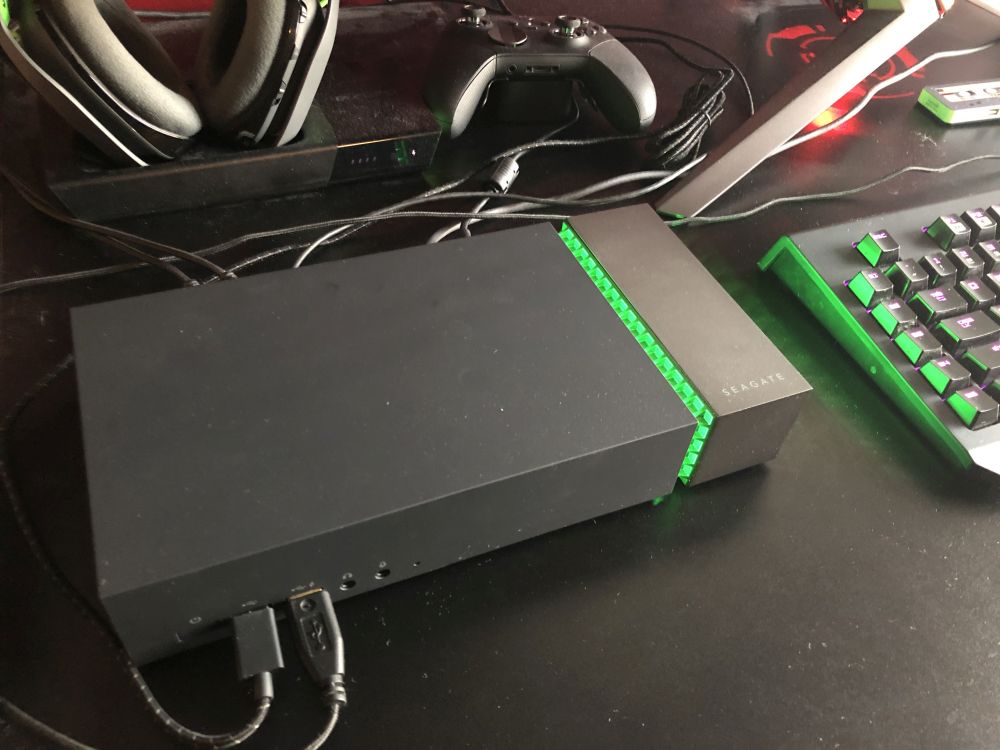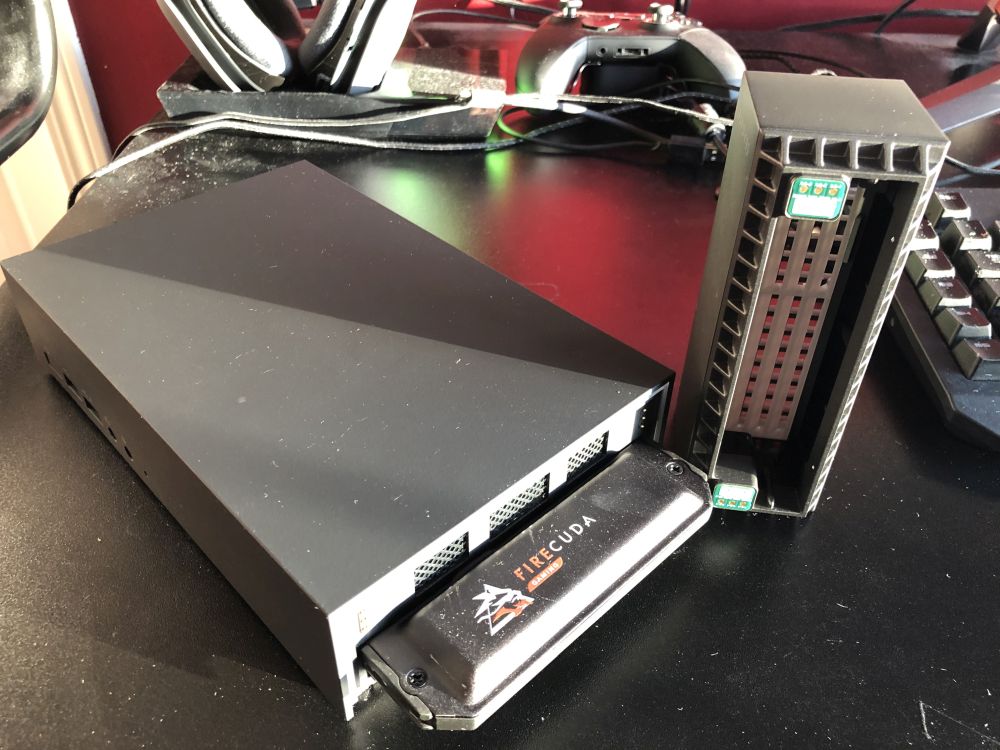
PC gaming rigs are becoming altogether more powerful and more complex all the time. Today serious PC gamers and streamers need all the disk space (and as many ports) as they can get their hands on. If you are looking for a way to streamline your setup with enough storage and ports to handle even the most robust setup, you may want to check out the Seagate FireCuda Gaming Dock.
This isn’t just another brick in the wall
Out of the box, the Seagate FireCuda Gaming Dock is a substantial accessory. It’s slightly larger than the size of an old Blockbuster movie rental, and weighs upwards of 5 lbs. That may seem a bit hefty at first, but just wait and see what sort of features the FireCuda packs in. For everything it does, it’s actually fairly sleek, compact, and stylish.
In fact, before digging into the impressive specifications, I’ll touch a bit more on aesthetics. After all, if you do wish to incorporate the Seagate FireCuda Gaming Dock into your gaming rig, you probably want to know if it will match the overall visual appeal. In this case, the FireCuda fits right in with most modern PC gaming accessories.
In addition to its sleek black casing, the Seagate FireCuda Gaming Dock also features programmable LED lighting. Many gamers already enjoy the ambiance of a glowing LED spectrum on their keyboards, mice, headsets, PC towers and more. If this is the case with your setup, the FireCuda will be right at home.
The Seagate FireCuda Gaming Dock can emit LED lighting across the RGB spectrum. It’s also fully programmable by utilizing the companion software tool on your PC. You can choose one solid colour, or set the FireCuda to cycle, flash, breathe and more through the entire spectrum.

Vast storage with fast speeds
Make no mistake however, this isn’t just a fancy glowing box. The Seagate FireCuda Gaming Dock serves two distinct and immensely useful purposes. The first feature I’ll touch on is: storage.
The device connects via a lightning-fast Thunderbolt 3 connection. Once it is connected to your desktop PC or laptop via the Thunderbolt 3 port, you will instantly have access to its gargantuan 4 TB HDD. For gamers with huge digital libraries across platforms such as Steam, Epic, Xbox Gamepass, and more, this means a whole lot of games!
The vast amount of additional space granted by the FireCuda can ensure more of your library is ready to play when you are. Not to mention it will also save bandwidth (and data cap concerns) in the long run. No more juggling your library or deleting and re-downloading games. With a full 4 TB of additional storage, gamers have much more freedom to manage their data and installation files.
Overall the speed of the Thunderbolt 3 connection is impressive indeed. I did not notice any discernible delay between accessing the FireCuda drive and accessing another internal drive on my gaming laptop. The performance was more than ideal when playing a game installed to the FireCuda drive as well.

Upgrade to even more epic speeds with an SSD
If 4 TB still isn’t enough, or if you crave something even more robust, Seagate still has you covered. The Seagate FireCuda Gaming Dock is fully designed with the ability for an SSD expansion in mind.
Removing the detachable end of the FireCuda grants access to an SSD expansion slot. Here owners can opt to purchase and install a blistering fast solid-state drive for even more impressive performance and load times. The FireCuda is compatible with internal Seagate SSD expansions, including the Seagate Firecuda 1TB PCie Internal Solid State Drive and Seagate Firecuda 2TB PCie Internal Solid State Drive.
The best part is that since the FireCuda is built with this expansion in mind, it really doesn’t affect the overall aesthetic. Not to mention the process of upgrading is incredibly easy. Simply pop the end cover off, insert the SSD into the expansion slot, and replace the cover. Now you have the same Seagate FireCuda Gaming Dock but with a massive and (relatively) economical SSD upgrade!

One hub to rule them all
If the Seagate FireCuda Gaming Dock were simply an external storage device, it would already be somewhat impressive. However, additional disk space is only half of the FireCuda’s dual purpose. It’s also a hub, with a lengthy list of useful ports to help you connect and manage all the devices that make up your gaming rig in one tidy place.
What ports are available on the FireCuda:
- Thunderbolt™ 3 port (for laptop connection)
- Thunderbolt 3 port (for accessory device)
- DisplayPort 1.4
- 4 USB 3.1 Gen2 ports
- USB 3.1 Gen2 battery-charge port
- RJ45 ethernet network port
- 3.5mm audio-in/mic port
- 3.5mm audio-out port
This is why the Seagate FireCuda Gaming Dock is so useful—particularly to those who game at home on their laptops. With one single Thunderbolt 3 connection, the FireCuda creates a wealth of ports for all your gaming peripherals. Not only that, but its mobility allows you to pack up and go with both your laptop and the very portable FireCuda gaming dock.
My only concern going in was what sort of latency might be involved with having so many devices running through one hub across a single Thunderbolt 3 connection. However, I had my mouse, keyboard, gamepad, cooling pad, and headset all connected via the FireCuda during my testing time, with no issues or lag. Everything felt the same as if I saw connected directly to my gaming laptop—and all this with ports to spare!

Elevate your PC gaming experience with the Seagate FireCuda Gaming Dock
Going in, I was modestly optimistic about just how useful an external drive/port hub the Seagate FireCuda Gaming Dock would be. However, after incorporating it into my PC gaming setup, I’m definitely sold. Between the huge boost in digital storage for my game library and a host of ports for easy connection and organization of all my devices and peripherals, the FireCuda is now the epicenter of my entire rig.
I’d absolutely recommend the FireCuda for those with elaborate setups for gaming and streaming—especially those like myself who use gaming laptops with limited ports or capacity for storage upgrades. Not to mention the appeal of the ambient LED lighting, which is just the cherry on top.




what is the Gb’s it support for the ethernet cable?
Comments are closed.